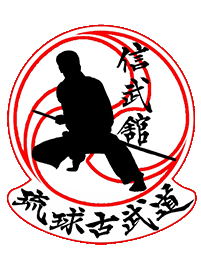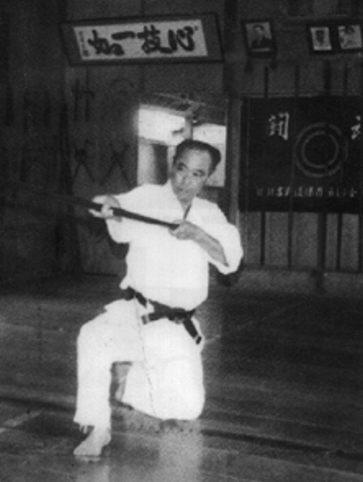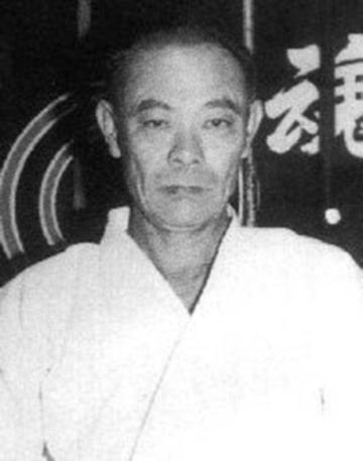|
Akamine Eisuke was born May 1, 1925 in the last years of the Taisho Era. Until his death on January 13, 1999, he lived in the Nesabu section of Tomigusuku, the small village in southern Okinawa where he was born.
In 1942, at the age of seventeen, he began the study of Yamani-Ryu bojutsu (staff art) under Higa Seichiro, Higa Raisuke, Higa Jisanburo and Akamine Yohei (no relation). From his early teachers, Akamine Sensei learned these kata; Soeshi no Kon, Sakugawa no Kon, Shirataru no Kon and Yuniga no Kon.
In 1944, Akamine Sensei married his wife, Shizuko. Shortly thereafter, at age nineteen, he was drafted into the Japanese Army where he served one year in Taiwan. When he returned to Okinawa, Akamine Sensei resumed vegetable and sugar cane farming and his study of Yamani-Ryu bojutsu.
|
|
|
In 1959, Taira Shinken was teaching Kobudo in a Goju-ryu Karate dojo in Naha, Okinawa. While there, he heard of great bojutsu teachers who lived in the Kakazu section of Tomigusuku village. To satisfy his curiosity, he went to Tomigusuku to study Yamani-ryu bojutsu with Akamine Sensei's teachers. This was the first meeting between Taira Shinken and Akamine Sensei.
One day, Taira was asked to demonstrate Tekko (metal knuckles), Nunchaku (horse bridle) and Sai (truncheon). Akamine Sensei had never seen these weapons before. He was so impressed with Taira's waza that he decided to become his deshi (student).
As Taira's senior student, Akamine Sensei would be in the unique position of watching him organize the various waza into a system that would eventually become Ryukyu Kobudo Hozon Shinkokai.
|
|
In addition to building a structured curriculum, Taira was adding a training element that would permeate all Ryukyu Kobudo waza and kata and as a result, become part of the signature of this weapons system. Higa Yuchoku was a student of Chibana Chosin and a noted teacher of "Te", the origin of Karate. Higa and Taira Shinken were close friends.
As he continued his relentless study, Taira recognized that Kobudo, while effective, lacked the explosive power found in Te. Specifically, it lacked gamanku (hip technique). Taira's ability to effectively demonstrate gamanku was limited by his rigid, muscular physique and a permanent ankle injury. However, he insisted on it from his students. So, he asked Higa Yuchoku to help infuse his system of Kobudo with gamanku. After Taira's death, Akamine Sensei continued to seek Higa's counsel on the use of gamanku.
|
|
|
In 1959, Taira Shinken was teaching Kobudo in a Goju-ryu Karate dojo in Naha, Okinawa. While there, he heard of great bojutsu teachers who lived in the Kakazu section of Tomigusuku village. To satisfy his curiosity, he went to Tomigusuku to study Yamani-ryu bojutsu with Akamine Sensei's teachers. This was the first meeting between Taira Shinken and Akamine Sensei.
One day, Taira was asked to demonstrate Tekko (metal knuckles), Nunchaku (horse bridle) and Sai (truncheon). Akamine Sensei had never seen these weapons before. He was so impressed with Taira's waza that he decided to become his deshi (student).
As Taira's senior student, Akamine Sensei would be in the unique position of watching him organize the various waza into a system that would eventually become Ryukyu Kobudo Hozon Shinkokai.
|
|
Akamine Sensei taught waza and kata for all of the nine weapons of Ryukyu Kobudo Hozon Shinkokai:
• Bo (Staff)
• Sai (Iron Truncheon)
• Nunchaku (Horse Bridle)
• Kama (Sickle)
• Tekko (Metal Knuckles)
• Tsuifa (Millstone Handle)
• Eiku (Oar)
• Suruchin (Weighted Rope)
• Tinbe (Shield and Short Spear)
|
|
|
In addition, Akamine Sensei continued Taira's tradition of research and with the help of his students, brought several kata back from extinction.
By all accounts, Akamine Sensei was a quiet and stern teacher whose primary focus was the development of waza. Within the Okinawan martial arts community, he was known as a teacher's teacher ... someone that teachers came to for a deeper understanding of their own techniques.
With a small dojo and a focus on quality rather than quantity, Akamine Sensei intentionally kept his student roster small. He only had fourteen first generation students.
|
Akamine Sensei once said, "If I teach you kata, you will forget it tomorrow. But, if I teach you waza, you will have it for a lifetime." |









